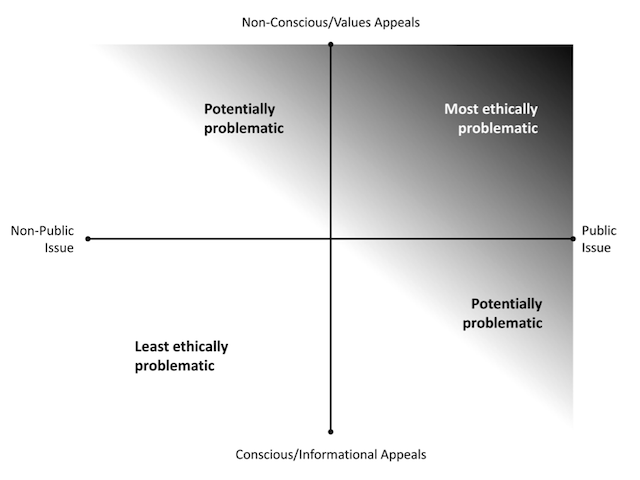November 01, 2012
Penn State Prof Develops New Way to Measure Ethics of Ads
A new approach to the ethical evaluation of advertising has been developed by a professor at Penn State University.
The advertising ethicality evaluative map (AEEM), conceived by Lee Ahern of Penn State’s College of Communications, separates individual advertisements on a four-quadrant map to enable people to see which ads may be problematic.
The AEEM employs a map (see example) with a horizontal “x” axis representing the extent to which an issue is public or non-public. The vertical “y” axis charts the extent to which an ad uses informational appeals or values appeals. Using this approach, ads can be placed into one of four AEEM quadrants: “most ethically problematic” at the upper right, “potentially problematic” at the lower right, “potentially problematic” at the upper left and “least ethically problematic” at the lower left.
“This analysis provides regulators, critics, audiences and advertisers with a useful tool for morally classifying approaches to persuasion that have heretofore avoided systematic scrutiny,” says Ahern, a Page Legacy Scholar in the Arthur W. Page Center for Integrity in Public Communication at Penn State.
Previous research has identified a hierarchy of advertising appeals along a continuum from concrete to abstract. Often called the “product benefits ladder,” this continuum places product attributes at the bottom. Higher up come product benefits or features, consumer benefits and finally values. Ads on the lower rungs of the ladder tend to be more informational in tone. Messages about abstract consumer benefits and values—higher on the ladder—are about emotion, and often rely on image advertising rather than information.
Ads touting products at the bottom of the product benefits ladder are the easiest to fact-check because they contain verifiable claims. Sophisticated “image” ads with few—or no—facts to check can be more problematic. “These appeals,” Ahern says, “often drop the delivery of linguistic information altogether. There is no truth or falsity to evaluate. Consumers have few, if any, cognitive defenses for them.”
“There is mounting empirical evidence that indirect image ads influence consumer attitudes and behaviors more strongly than consciously mediated persuasive information,” writes Ahern in a chapter of a new book titled Talking Green: Exploring Contemporary Issues in Environmental Communications.
Ahern believes that individual ads can be evaluated subjectively as to the nature and level of non-conscious techniques and image/value appeals they use. He also says that ads can be assessed on the degree to which they represent a public issue.
His premise is that issues of public concern “should be presented in a way that allows audiences to engage in rational debate and evaluation of the explicit and implicit claims being made.”
By considering how public an issue is, and how much an ad message operates indirectly, Ahern believes it is possible to see when the use of non-conscious ad techniques is ethically problematic.
Ahern cites as examples two ads: one by BP (pre-oil spill) and one by Nissan.
The BP ad featured a carload of animated children driving through a green landscape forested with gently spinning turbines. When the gas gauge gets low they shun a number of dingy gray gas stations and pull in to the green sunburst BP logo where their car is filled by a smiling green gas pump. After they drive off into the BP-logo sunset, the firm’s “Beyond Petroleum” tagline appears.
A more recent Nissan Leaf ad features a polar bear departing the Arctic for a hazardous trip to suburbia. With difficulty, the bear finds the driveway he has been looking for. A man leaves his house for work and is about to get into his Leaf when the bear comes around the back of the car, rises up on its rear legs—and gives the man a hug.
As environmentalism is a highly public issue, Ahern would place both the BP and Nissan ads near the right end point on the non-public/public axis of the AEEM. The messages of the ads, however, differ in their levels of non-conscious appeal.
“The BP ad evokes a “green world” and associates its brand with this value. But it provides no information as to how the brand is instrumental in achieving it. Does BP use wind turbines to power its gas stations? Is BP gas produced and marketed using more sustainable practices compared to the competition? No such claims or connections are presented. This ad, therefore, would be placed near the top end-point in terms of the non-conscious/values appeals employed.”
And that lands the BP ad high in the upper right quadrant of the AEEM, marking it as “most ethically problematic.”
The Nissan ad also uses non-conscious persuasive techniques and values imagery. The ad, however, does make a clear claim that the audience can rationally evaluate. The degree to which lower emissions from an electric car reduces greenhouse gases, can be empirically verified.
“Subjectively placing the ad near the mid-point on the non-conscious/appeal graph seems appropriate,” Ahern says. That puts the Nissan ad in the “potentially problematic” quadrant.
Ahern says that as the AEEM develops, specific guidelines can be developed for “grading” the levels of non-conscious appeals.
Ahern’s chapter is titled, “Evaluating the Ethicality of Green Advertising: Toward an Extended Analytical Framework.” It is chapter nine in Talking Green, an anthology, of which he is co-editor, just published by Peter Lang International Publishing Group. His work was supported by a grant from the Arthur W. Page Center for Integrity in Public Communication.
For more information contact Lee Ahern

Above, the Advertising Ethicality Evaluative Map, developed by Lee Ahern, Page Legacy Scholar in the Arthur W. Page Center for Integrity in Public Communication at Penn State University.
CONTACT: Lee Ahern
